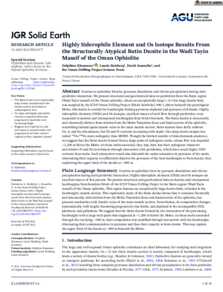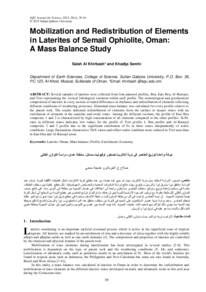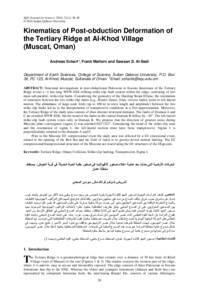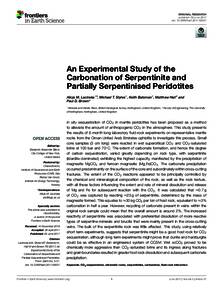وثيقة
Highly siderophile element and Os isotope results from the structurally atypical batin dunite in the Wadi Tayin massif of the Oman ophiolite.
المعرف
DOI: 10.1029/2021JB021977
المصدر
Journal of Geophysical Research: Solid Earth. v. 126, 10, e2021JB021977
المساهمون
Reisberg, Laurie., مؤلف
Jousselin, David., مؤلف
الدولة
United States.
الناشر
John Wiley and Sons Inc.
ميلادي
2021-10-01
اللغة
الأنجليزية
الملخص الإنجليزي
Dunites in ophiolites form by pyroxene dissolution and olivine precipitation during melt-peridotite interaction. We present structural and geochemical data on peridotites from the Batin region (Wadi Tayin massif) of the Oman ophiolite, where an exceptionally large (∼9.5 km long) dunite body was sampled by the ICDP Oman Drilling Project (BA4A borehole). 900–1,200 m beneath the petrological Moho, this dunite is overlain by harzburgite hosting pyroxene-depleted and pyroxene-rich bands. Highly siderophile elements (HSEs) and Os isotopes, excellent tracers of melt flow through peridotites, were measured in dunites and interspersed harzburgites from BA4A borehole. The Batin dunite is structurally and chemically distinct from dunites from the Moho Transition Zone and basal section of the ophiolite, resembling instead sparse dunite veins in the main mantle section. Batin dunites have fairly uniform Os, Ir, and Ru abundances, but Pd and Pt contents increasing with depth. One deep dunite sample has initial 187Os/188Os more radiogenic than MORB. Though the limited number of data demands prudence, we suggest that the Batin dunite formed from a large pulse of radiogenic melts, whose flow was impeded ∼1,200 m below the Moho. As these melts ascended, they may have lost their radiogenic character and relative Pt and Pd enrichment through interaction with peridotites, which have much higher HSE contents than melts. Such interaction would also diminish the under-saturation in pyroxene of the melts, eliminating their capacity to sufficiently dissolve the pyroxene of the host harzburgite to form dunite, thus explaining the upper limit of the dunite at ∼900 m.
ISSN
2169-9313
قالب العنصر
مقالات الدوريات




